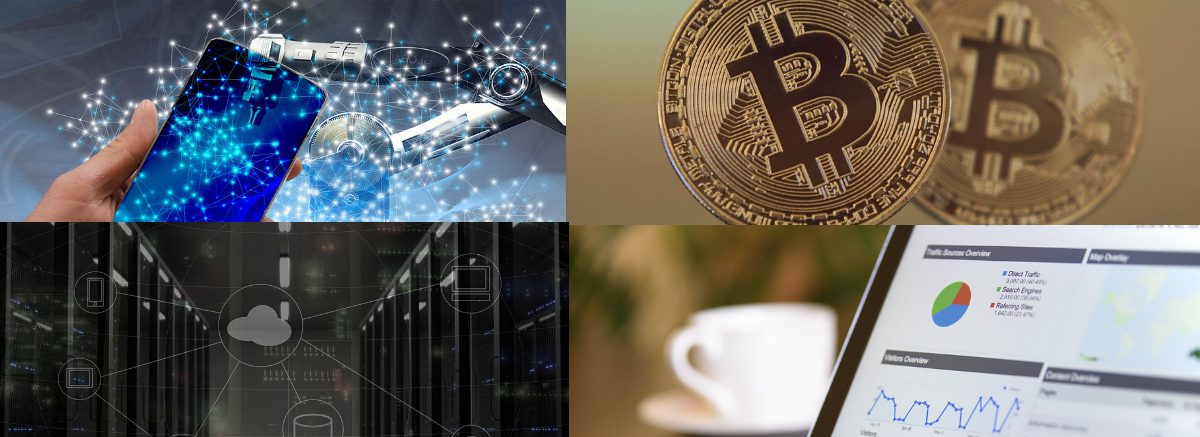- Contact us
- +599-9 461 4545
- info@dcsx.cw
The ABCDs of FinTech

FinTech: Hype or What?
February 23, 2021
The Curaçao Investor Permit Program (CIPP) and the DCSX
May 7, 2021The ABCDs of FinTech

Publication 2. 2021
Fintech has been transforming the financial sector during the last decade with the rise of alternative finance through new business models and numerous new technologies. In order not to get lost, we have narrowed down things to 4 key specific and interrelated technologies that have a significant impact and allow alternative finance to rise. These technologies include:
- Artificial intelligence, or AI;
- Blockchain:
- Cloud computing, and:
- Data.
We could call them collectively the ABCDs of Fintech. Let us discuss them in reverse order.
Data
Banks for the longest time have generated and subsequently relied upon large amounts of information. These include information from and about customers: their identity, their transactions, their net worth and even their relationships and full contact details. Most of the data was gathered by using paper forms filled in by customers and bank staff and not easily searchable or manipulated for analysis.
The digitization of information, from paper to digital data, allows information to be more easily stored, transmitted, searched, processed, analyzed, and displayed. This digitization facilitates online banking and allows capital marketplaces to manage client information better. Data gatherers can now “more cost-effectively” process and analyze the data for those who need the capital and then display the relevant information on the new platforms for the potential providers of capital to make their own investment decisions.
At the same time, digital form filling and tracking of the online customer activity allows both online platforms like virtual banks and brokers to scale more quickly with less manual labor and space resources that would otherwise be required for, for example, traditional bank branch networks. Customer data includes information about the customer’s online behavior such as the time and location of logging in and executing transactions as well as, other online activities such as web browsing, e-commerce, and social media use.
Increasingly, the offline behavior of the customer is also being tracked through data from internet of things (IoT) devices such as smart home devices like the Amazon Echo or any other electronic device connected to the internet, wearable smartwatches, smart cars, etc.
Data has been called the new oil that is being collected (in most cases for free), bought and sold by gatherers and users, and increasingly fueling the AI engine. For example, the world’s biggest retailer, Walmart, processes 2.5 petabytes of data every hour. One petabyte is 10 bytes with 15 “0”s afterward.
Cloud Computing
In the old days, businesses such as financial institutions had to build their IT systems using different enterprise-level software that was developed or licensed at high cost over time and hosted on large servers which were located on-site or on third party premises “in the neighborhood”. With the rise of so-called “cloud computing”, software resides at specialized data centers on servers abroad owned by -often times very large- companies dedicated to managing such servers which also provide value-added services such as cybersecurity protection. This means that new businesses such as alternative financial providers no longer need to spend large amounts of money in expensive infrastructure instead, they focus on improving their clients’ experience and can dynamically scale their server usage in accordance with their needs and rates of growth.
Cloud computing also contributed to the growth of new business models. Software as a service or “SaaS” businesses bypass and actually replace the traditional vendor model of software development and sales that require marketing software licenses at high upfront fees and then again, each time there is a new version rolled out. Software that resides in the cloud can now be marketed at a lower upfront cost based on a subscription model. And software upgrades can be automatically made on a continuous basis which gives the client one less reason to switch vendors. This means that online capital marketplaces, as well as startup virtual banks, require less upfront costs to prototype new business models and user interfaces to roll out more quickly and cost-effectively and to do the same when scaling to new jurisdictions.
Additionally, this cloud computing enables connected IoT devices to gather data and stream more services including financial services to customers through new interfaces like smartwatches, voice-activated speakers, and the like. Cloud computing effectively facilitates institutional level technology support to retail businesses whereby user customers can now more easily make transactions from their office computer, via their smartphones, smart cars, or at home in their pajamas.
Blockchain
Distributed ledger technology or DLT continues to have an evolving impact on alternative finance. The oldest example of double-entry bookkeeping can be found in the publication in 1494 by Franciscan Friar Luca Pacioli who created a reliable form for documenting information about both creditor and debtor in a standardized manner. The white paper on Bitcoin by the mysterious Satoshi Nakamoto in 2008 was similarly revolutionary in establishing a cryptocurrency that seeks to solve the double-spending problem intrinsic in a currency based on software without the need of a trusted authority or central server.
Nakamoto postulated a ledger that is distributed via a peer-to-peer network that records transactions in a chain of blocks. Each block is validated by different node computers in the network through solving cryptographic mathematical puzzles, or hashes, at which time a new block with a new cryptographic hash, timestamp, and data would be added to the chain which is transparent to all users. Data on the block is immutable and effectively cannot be altered unless all prior blocks in the chain are altered by consensus or with the agreement of the network majority.
Blockchain is the underlying technology behind cryptocurrencies that have expanded dramatically beyond Bitcoin. This technology has created a new form of digital asset and a new alternative finance method to raise capital for new projects, with the so-called crypto exchanges comprising new forms of online capital marketplaces. In addition, blockchain technology could and will probably form the basis of a new capital markets infrastructure.
As time goes by, we see more businesses and institutions interested in using the technologies. NASDAQ is using blockchain technologies to secure record-keeping of ownership of private companies and transfers. In December 2017, Australia’s ASX announced that it would replace its stock exchange registry, settlement, and clearing system with blockchain technology. An even more ambitious use of blockchain technology is through the creation of distributed autonomous organizations or DAOs that allow for automatic execution upon specific conditions via smart contracts, with innovative governance mechanisms based on direct voting and consensus. If implemented to its fullest extent, DAOs and their efforts to disintermediate could impact not only the venture capital market but also the very concept of the joint-stock company and even some functions of government.
Artificial Intelligence
The term artificial intelligence originated at the now-famous Dartmouth Summer Research Workshop in 1956. Initially, it referred to what we now know as the narrow or weak AI that relates to an algorithm performing specific tasks, as opposed to general or strong AI that reflects the broader human intelligence and decision-making we know today.
According to Mr. Brian Tang, Managing Director at Asia Capital Markets Institute (ACMI), there are different strands within AI, including Natural Language Processing or NLP which relates to language, often written, and Machine Learning where systems learn from experience by being trained with data as opposed to being rules-based. There are many techniques within Machine Learning, including so-called neural networks which comprise nodes of weighted interconnectedness inspired by the human brain, and deep learning, which refers to algorithms based on neural networks arranged in several deeper layers. Computer vision for image recognition is a good example of machine learning. To be more precise, several facial recognition applications.
There has been a long period of stagnant activity in the area of AI development, the so-called AI winter of lackluster activity lasting from the 1980s reaching 2017. During this period the lack of interest made it difficult to obtain funding for AI-based projects. Then in 2017, a miracle happened: AI blossomed due to a confluence of events that made both Fortune and Forbes name 2017 the year of AI.
First, instead of expensive large supercomputers required for the AI algorithmic processing, researchers started using relatively cheap graphical processing units or GPUs originally developed for video games with increased computational power when used in parallel.
Second, data storage cost continues to fall while data is being gathered at alarming rates and speeds through online activity and connected devices, thereby allowing for more structured and unstructured data to be gathered, stored, and used to train the machines.
Third, most major cloud computing companies, such as Amazon’s AWS, Google Cloud, Microsoft’s Azure, IBM Cloud, and Alibaba’s Aliyun incorporated AI into their services, often including machine learning frameworks on some open-source basis to allow their clients to experiment and incorporate into their operations.
For example, AI is rapidly changing Alternative Finance user interfaces, from facial and voice recognition for biometric identity management to chatbots that can provide personalized recommendations. Algorithmic matching of needs, pricing, and predictive analytics are also being used. AI also allows some alternative finance companies to create new business models that focus on analytics of the customer data rather than building platforms to provide financial fund flow. For example, some Chinese companies which started primarily as P2P lending companies have pivoted to provide credit analysis and scoring that serve the marketplace lending conducted by institutional investors and lenders.
Final Thoughts
Undoubtedly, Artificial Intelligence, Blockchain, Cloud Computing, and Data are major influencers in the development and growth of alternative finance and are driving forces of FinTech. We do recognize the challenges for traditional financial institutions when adapting to these technologies. Acknowledging the challenges does not mean giving up and continue the traditional way. Innovation is an important factor for survival for business in the Financial Industry. We saw how some existing companies outside of the financial industry dared to dive into unknown territories such as offering financial services to their customers. This originated another disruption in the industry known as TechFin.
With TechFin we see how financial services are provided by large technological companies which already have their own platform with a large number of daily users. These include Google, Amazon, Facebook, and Apple, collectively known as GAFA from the US, and Baidu, Alibaba, and Tencent, collectively known as BAT from China. In our next publications, we will discuss more about TechFins.
Sources
ASX. About CHESS Replacement: CHESS Replacement process. Last visited January 15, 2021. https://www2.asx.com.au/markets/clearing-and-settlement-services/chess-replacement/about-chess-replacement
Blockchainhub Berlin. Tokenized Networks: What is a DAO? Last visited January 15, 2021. https://blockchainhub.net/dao-decentralized-autonomous-organization/
Darthmouth. 1956. Artificial Intelligence (AI) coined at Darthmouth. Retrieved February 17, 2021: https://250.dartmouth.edu/highlights/artificial-intelligence-ai-coined-dartmouth
French, J. April 23, 2018. Nasdaq Exec: Exchange Is ‘All-In’ on Using Blockchain Technology. Last visited January 15, 2021. https://www.thestreet.com/investing/nasdaq-all-in-on-blockchain-technology-14551134
Jessel, Ben. July 13, 2020. Nasdaq’s Digital Assets Boss Explains Future Blockchain Assets. Retrieved February 16, 2021. https://www.forbes.com/sites/benjessel/2020/07/13/where-are-digital-asset-headed–nasdaqs-digital-assets-head-johan-toll-explains/?sh=6869c7aeea6b
Lashinsky, A. December 30, 2016. 2017 Will Be the Year of AI. Fortune. Last visited January 15, 2021. https://fortune.com/2016/12/30/the-year-of-artificial-intelligence
University of Hong Kong. 2020. Course Introduction to Fintech: Module 2 Payment, Cryptocurrencies & Blockchain presented by Instructor Brian Tang, Managing Director at Asia Capital Markets Institute (ACMI). Last visited February 17, 2021. https://www.edx.org/course/introduction-to-fintech
Venkatachalam, S. Feb 27, 2017. Why 2017 Is The Year Of Artificial Intelligence. Forbes. Last visited February 6, 2021: https://www.forbes.com/sites/forbestechcouncil/2017/02/27/why-2017-is-the-year-of-artificial-intelligence/?sh=61c2965657a1
This publication is presented to you by the Dutch Caribbean Securities Exchange
Written by N. Martina. Edited by D. Intriago and R. Römer.
Download the PDF version of this article: EN




